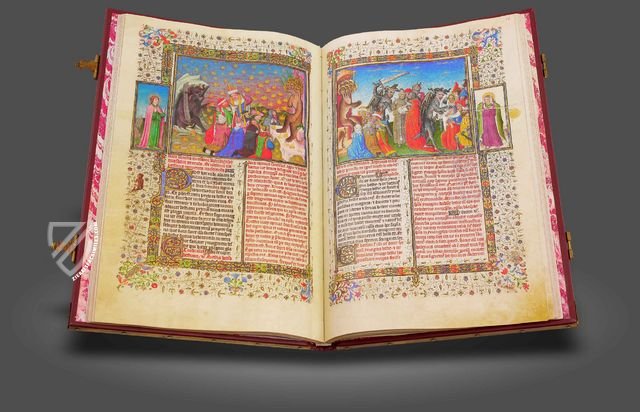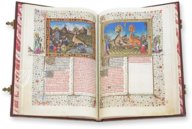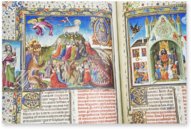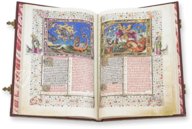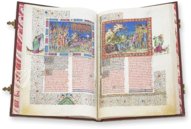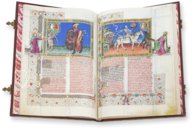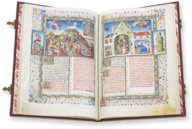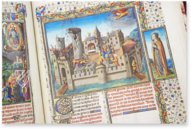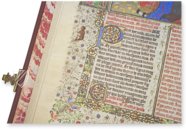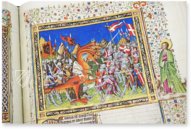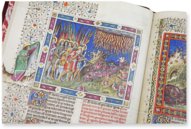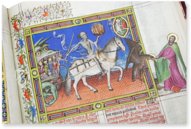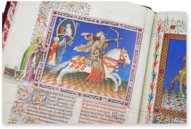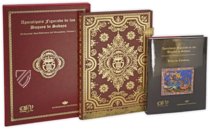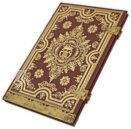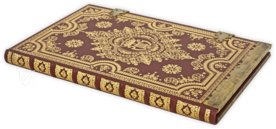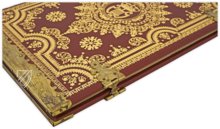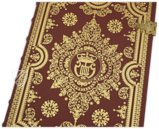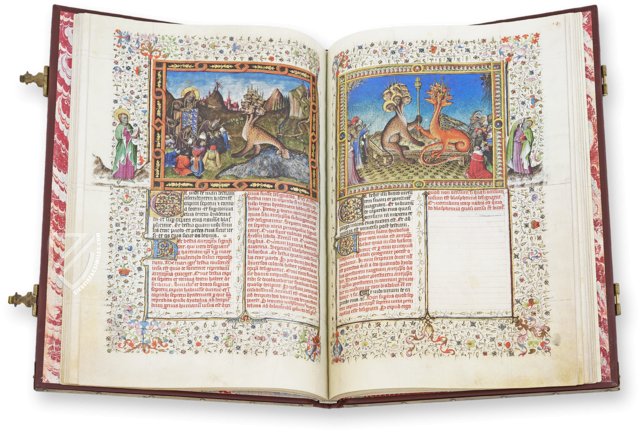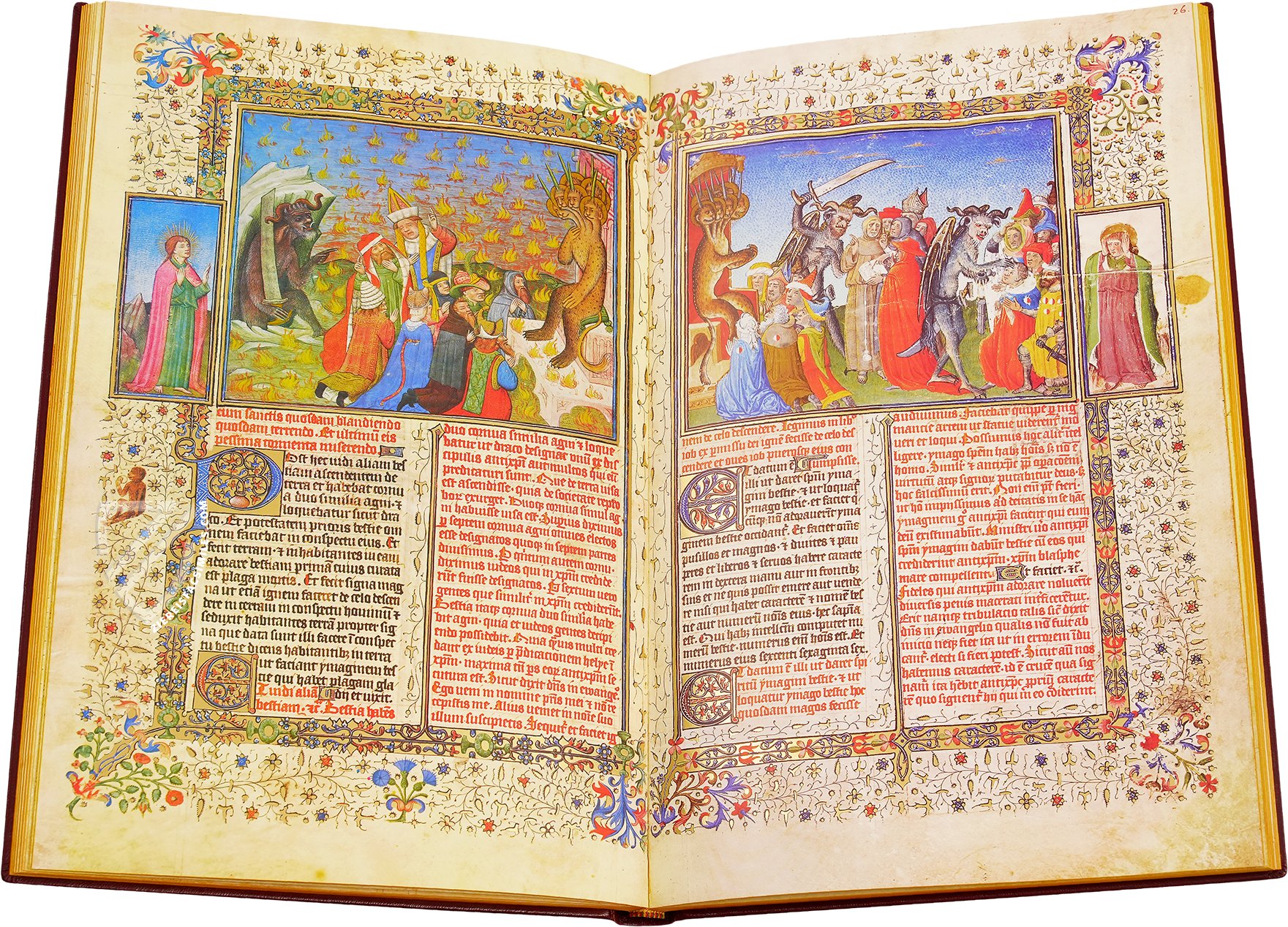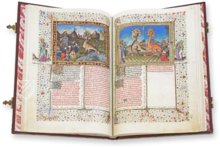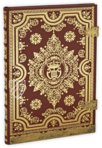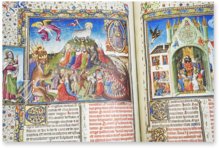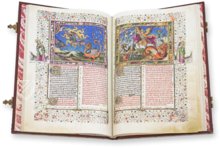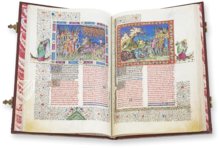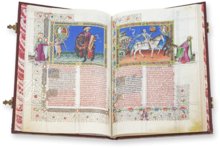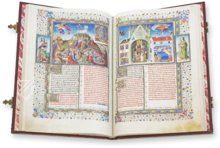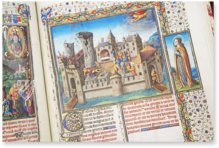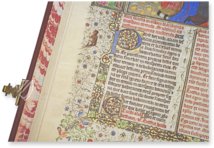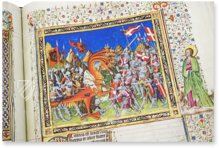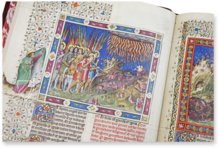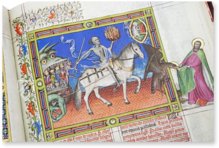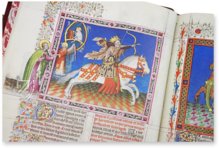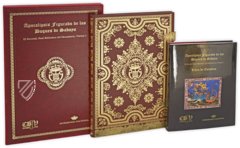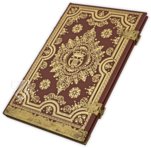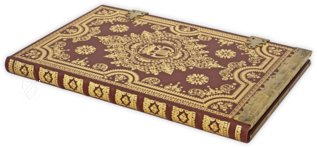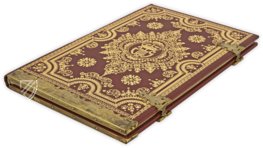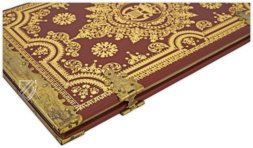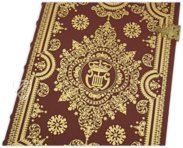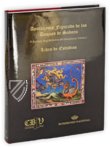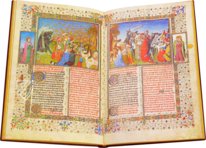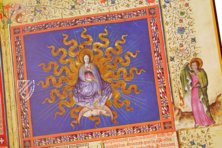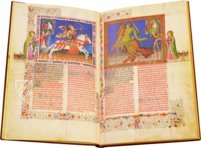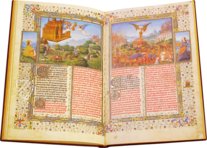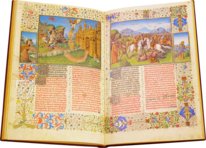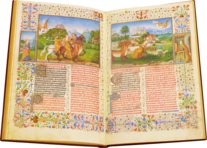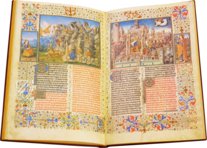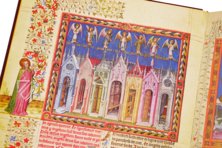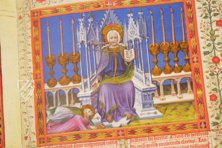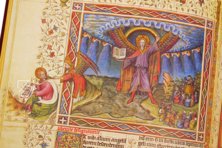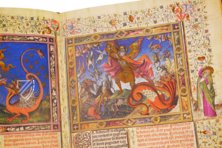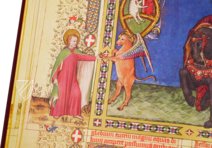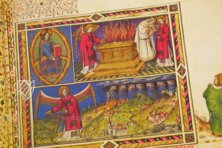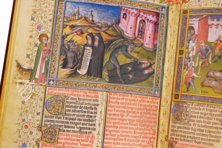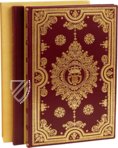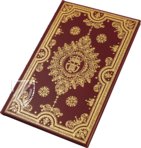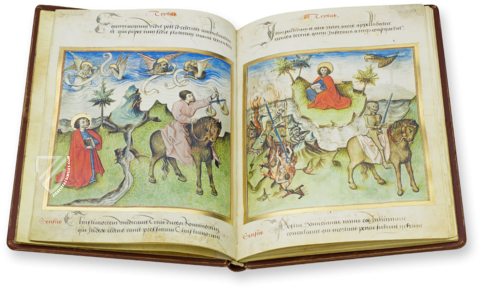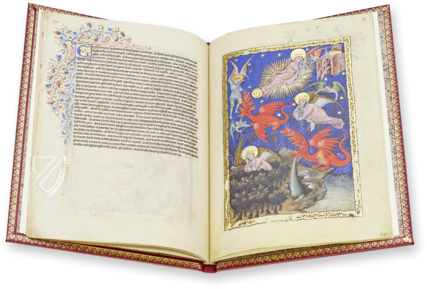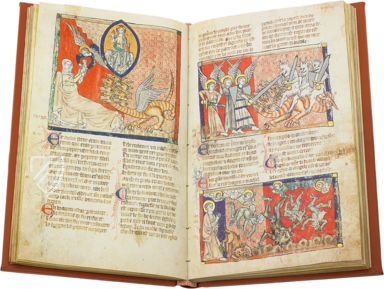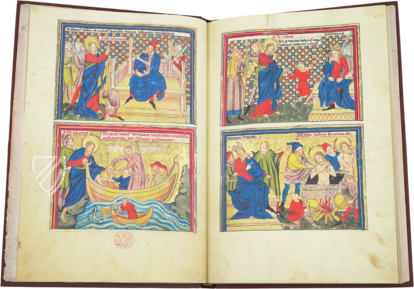Apocalypse of the Dukes of Savoy
(3,000€ - 7,000€)
The Apocalypse of the Dukes of Savoy can be certainly called one of the most beautifully illuminated manuscripts of the Middle Ages. This precious and large-scale masterpiece was created in two stages between 1428 and 1490 and some the greatest French illuminators participated in its manufacture including Jean Bapteur, Péronet Lamy, and Jean Colombe. Duke Amadeus VIII of Savoy commissioned the work in 1428, but it remained unfinished when he took it with him in 1434 to Château de Ripaille, where he lived in quasi-monastic seclusion with six other knights, with whom he founded the Order of Saint Maurice. His great-grandson Charles I inherited the manuscript and had it completed between 1485 and 1490 by his court painter Jean Colombe. 97 Gothic miniatures, which are thoughtfully arranged with the corresponding texts, account for the special charm of the fantastic picture book, nearly every page of which is magnificently illuminated. The enchanting marginal motifs include colorful floral tendrils with golden leaves, animals, and birds.
Apocalypse of the Dukes of Savoy
The Apocalypse of the Dukes of Savoy is a precious manuscript that was written and illuminated by the famous French book master Jean Bapteur. The precious, gorgeously designed codex contains 97 miniatures altogether, which are ordered according to a well-thought system. Nearly every page of the document is magnificently illuminated. The codex originated at the behest of the Dukes of Savoy, in particular Duke Amadeus VIII has been associated with this valuable Apocalypse manuscript.
A Turbulent History
Amadeus VIII, the first Duke of Savoy, commissioned the manuscript in the year 1428. He entrusted his court painter Jean Bapteur with its design. Beginning in 1433, Bapteur was supported by the no-less-talented illuminator Peronet Lamy. This prolonged design period makes it clear what outstanding quality the precious book treasure possesses. 47 pages of the document are considered to be the work of Bapteur. The remaining pictures he designed in collaboration with Peronet Lamy, a few of them originate wholly from Lamy’s pen. In the year 1434, Duke Amadeus withdrew to the Château de Ripaille near Thonon-les-Bains. He took the yet-incomplete Apocalypse with him, in order to read it aloud to himself. In 1468 his great-grandson Charles I had the work completed by his court painter Jean Colombe. This was at the very same time that he was occupied with the legendary and world famous book treasure known as the Très Riches Heures du duc de Berry. Colombe appended the Apocalypse of the Dukes of Savoy with 23 missing pictures and took special care to adhere to the design system of its originator, Bapteur.
Traditional Work
The work is an abridged version of the Book of Revelation, written in black ink and accompanied by a traditional commentary by the monk Berengaudus. Red characters highlight important text elements. The special approach to the biblical text with a clarifying commentary was widespread in the spiritual literature of medieval France. The text and also the illustration of the masterpiece are strongly oriented on similar works from England. The primary source of inspiration was probably the Apocalypse of Lambeth Palace.
A Highpoint of Medieval Book Art
The manuscript contains 104 pages altogether. The pages are all designed according to a sophisticated system. The upper part of a page always contains a miniature, which illustrate the text under the image. It contains 97 miniatures, only the last pages of the work were not illustrated. The vignettes of the miniatures typically exhibit a depiction of John the Evangelist. This depiction corresponds generally with the primary scene of the respective illustration. Enchanting and diverse motifs adorn the page margins, one sees animal patterns, plant tendrils, and other playful patterns.
Codicology
- Alternative Titles
- Figurated Apocalypse of the Dukes of Savoy
Apocalipsis figurado de los Duques de Saboya
Apokalypse der Herzöge von Savoyen - Size / Format
- 104 pages / 41.5 × 26.5 cm
- Origin
- France
- Date
- Between 1428 and 1490
- Epochs
- Style
- Genre
- Language
- Script
- Gothic Textura
- Illustrations
- 97 half-page miniatures; 97 floral borders, 91 of them with figurative depictions; 185 decorated initials
- Content
- Vita of St. John and Revelation of John with Berengaudus commentary
- Patron
- Duke Amadeus VII of Savoy
- Artist / School
- Jean Bapteur (fl. 1427–58) (scribe and illuminator)
Péronet Lamy (d. 1453) (illuminator)
Jean Colombe (ca. 1430 – ca. 1493) (illuminator)
Apocalypse of the Dukes of Savoy
The Pale Horseman
“And I looked, and behold, a pale horse, and his name that sat on him was Death, and Hell followed with him...” (Rev. 6:8). The Fourth Horseman comes forth as the Lamb of God breaks the Fourth Seal in the upper-right corner. He is not only followed by the Hellmouth, but pulls it with wheels made of the contorted bodies of demons on a herring-bone patterned brick road. An eagle strikes out at St. John in the margin as the strife of the Apocalypse even puts him in conflict with his own symbol.
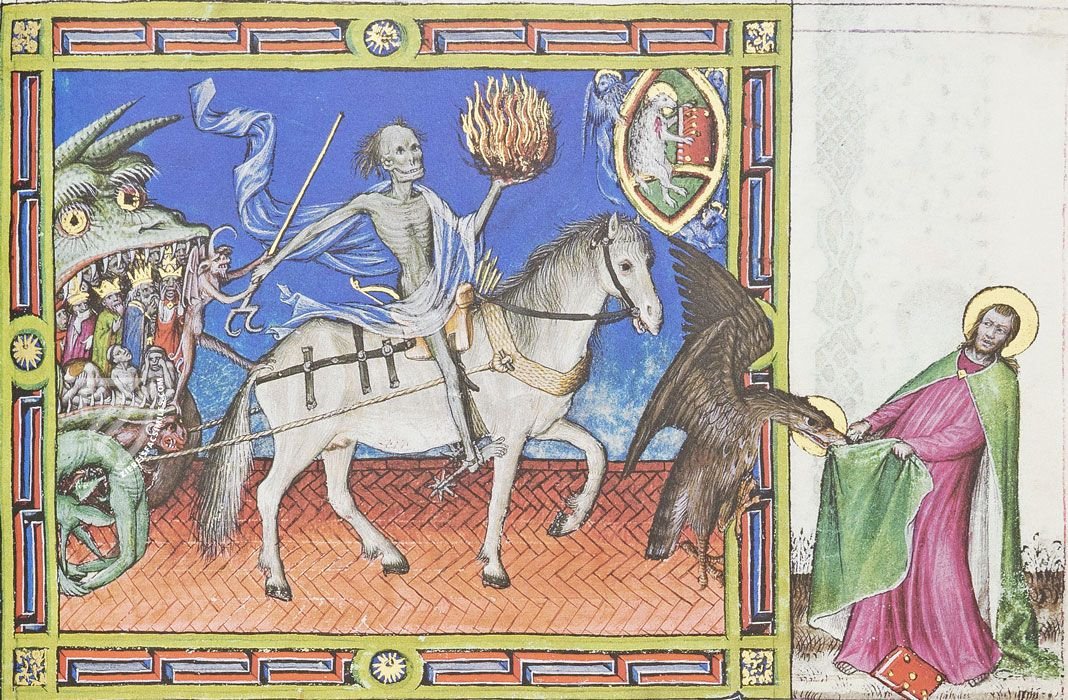
Apocalypse of the Dukes of Savoy
Martyrdom of St. John
Although most modern scholars agree that the author of the Book of Revelation was a certain John of Patmos, during the Middle Ages it was still believed that it was the work of John the Evangelist, who wrote the Fourth Gospel. Medieval iconography concerning him is rooted in the apocryphal Acts of St. John, in which the Evangelist is martyred when he is plunged into a vat of boiling oil.
The story of John and his martyrdom is typically presented at the beginning of medieval Apocalypse manuscripts, but rarely with the degree of artistic refinement found here. The finest pigments and gold leaf have been employed with realistically rendered people clothed in the fashions of Renaissance Italy. All is presented within a frame of elegant floral tendrils.
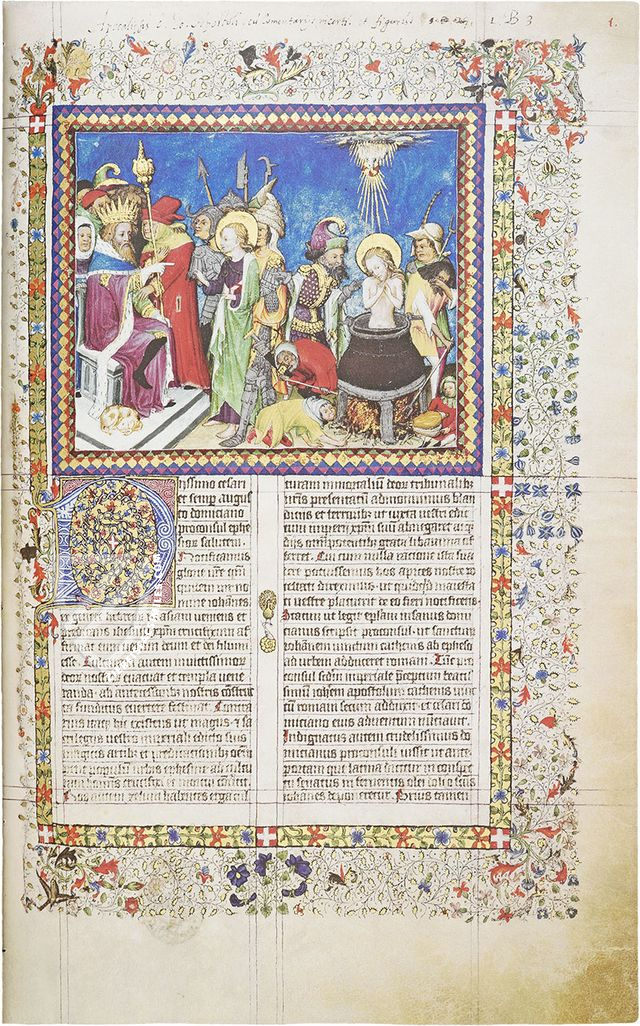
#1 Apocalipsis Figurado de los Duques de Saboya
Language: Spanish
(3,000€ - 7,000€)
#2 Apocalipsis figurado de los Duques de Saboya
Language: Spanish
(1,000€ - 3,000€)
- Treatises / Secular Books
- Apocalypses / Beatus
- Astronomy / Astrology
- Bestiaries
- Bibles / Gospels
- Chronicles / History / Law
- Geography / Maps
- Saints' Lives
- Islam / Oriental
- Judaism / Hebrew
- Single Leaf Collections
- Leonardo da Vinci
- Literature / Poetry
- Liturgical Manuscripts
- Medicine / Botany / Alchemy
- Music
- Mythology / Prophecies
- Psalters
- Other Religious Books
- Games / Hunting
- Private Devotion Books
- Other Genres
- Afghanistan
- Armenia
- Austria
- Belgium
- Belize
- Bosnia and Herzegovina
- China
- Colombia
- Costa Rica
- Croatia
- Cyprus
- Czech Republic
- Denmark
- Egypt
- El Salvador
- Ethiopia
- France
- Germany
- Greece
- Guatemala
- Honduras
- Hungary
- India
- Iran
- Iraq
- Israel
- Italy
- Japan
- Jordan
- Kazakhstan
- Kyrgyzstan
- Lebanon
- Liechtenstein
- Luxembourg
- Mexico
- Morocco
- Netherlands
- Palestine
- Panama
- Peru
- Poland
- Portugal
- Romania
- Russia
- Serbia
- Spain
- Sri Lanka
- Sweden
- Switzerland
- Syria
- Tajikistan
- Turkey
- Turkmenistan
- Ukraine
- United Kingdom
- United States
- Uzbekistan
- Vatican City
- A. Oosthoek, van Holkema & Warendorf
- Aboca Museum
- Ajuntament de Valencia
- Akademie Verlag
- Akademische Druck- u. Verlagsanstalt (ADEVA)
- Aldo Ausilio Editore - Bottega d’Erasmo
- Alecto Historical Editions
- Alkuin Verlag
- Almqvist & Wiksell
- Amilcare Pizzi
- Andreas & Andreas Verlagsbuchhandlung
- Archa 90
- Archiv Verlag
- Archivi Edizioni
- Arnold Verlag
- ARS
- Ars Magna
- ArtCodex
- AyN Ediciones
- Azimuth Editions
- Badenia Verlag
- Bärenreiter-Verlag
- Belser Verlag
- Belser Verlag / WK Wertkontor
- Benziger Verlag
- Bernardinum Wydawnictwo
- BiblioGemma
- Biblioteca Apostolica Vaticana (Vaticanstadt, Vaticanstadt)
- Bibliotheca Palatina Faksimile Verlag
- Bibliotheca Rara
- Boydell & Brewer
- Bramante Edizioni
- Bredius Genootschap
- Brepols Publishers
- British Library
- C. Weckesser
- Caixa Catalunya
- Canesi
- CAPSA, Ars Scriptoria
- Caratzas Brothers, Publishers
- Carus Verlag
- Casamassima Libri
- Centrum Cartographie Verlag GmbH
- Chavane Verlag
- Christian Brandstätter Verlag
- Circulo Cientifico
- Club Bibliófilo Versol
- Club du Livre
- CM Editores
- Collegium Graphicum
- Collezione Apocrifa Da Vinci
- Comissão Nacional para as Comemorações dos Descobrimentos Portugueses
- Coron Verlag
- Corvina
- CTHS
- D. S. Brewer
- Damon
- De Agostini/UTET
- De Nederlandsche Boekhandel
- De Schutter
- Deuschle & Stemmle
- Deutscher Verlag für Kunstwissenschaft
- DIAMM
- Droz
- E. Schreiber Graphische Kunstanstalten
- Ediciones Boreal
- Ediciones Grial
- Ediclube
- Edições Inapa
- Edilan
- Editalia
- Edition Deuschle
- Edition Georg Popp
- Edition Leipzig
- Edition Libri Illustri
- Editiones Reales Sitios S. L.
- Éditions de l'Oiseau Lyre
- Editions Medicina Rara
- Editorial Casariego
- Editorial Mintzoa
- Editrice Antenore
- Editrice Velar
- Edizioni Edison
- Egeria, S.L.
- Eikon Editores
- Electa
- Emery Walker Limited
- Enciclopèdia Catalana
- Eos-Verlag
- Ephesus Publishing
- Ernst Battenberg
- Eugrammia Press
- Extraordinary Editions
- Fackelverlag
- Facsimila Art & Edition
- Facsimile Editions Ltd.
- Facsimilia Art & Edition Ebert KG
- Faksimile Verlag
- Feuermann Verlag
- Folger Shakespeare Library
- Franco Cosimo Panini Editore
- Friedrich Wittig Verlag
- Fundación Hullera Vasco-Leonesa
- G. Braziller
- Gabriele Mazzotta Editore
- Gebr. Mann Verlag
- Gesellschaft für graphische Industrie
- Getty Research Institute
- Giovanni Domenico de Rossi
- Giunti Editore
- Graffiti
- Grafica European Center of Fine Arts
- Guido Pressler
- Guillermo Blazquez
- Gustav Kiepenheuer
- H. N. Abrams
- Harrassowitz
- Harvard University Press
- Helikon
- Hendrickson Publishers
- Henning Oppermann
- Herder Verlag
- Hes & De Graaf Publishers
- Hoepli
- Holbein-Verlag
- Houghton Library
- Hugo Schmidt Verlag
- Idion Verlag
- Il Bulino, edizioni d'arte
- ILte
- Imago
- Insel Verlag
- Insel-Verlag Anton Kippenberger
- Instituto de Estudios Altoaragoneses
- Instituto Nacional de Antropología e Historia
- Introligatornia Budnik Jerzy
- Istituto dell'Enciclopedia Italiana - Treccani
- Istituto Ellenico di Studi Bizantini e Postbizantini
- Istituto Geografico De Agostini
- Istituto Poligrafico e Zecca dello Stato
- Italarte Art Establishments
- Jan Thorbecke Verlag
- Johnson Reprint Corporation
- Josef Stocker
- Josef Stocker-Schmid
- Jugoslavija
- Karl W. Hiersemann
- Kasper Straube
- Kaydeda Ediciones
- Kindler Verlag / Coron Verlag
- Kodansha International Ltd.
- Konrad Kölbl Verlag
- Kurt Wolff Verlag
- La Liberia dello Stato
- La Linea Editrice
- La Meta Editore
- Lambert Schneider
- Landeskreditbank Baden-Württemberg
- Leo S. Olschki
- Les Incunables
- Liber Artis
- Library of Congress
- Libreria Musicale Italiana
- Lichtdruck
- Lito Immagine Editore
- Lumen Artis
- Lund Humphries
- M. Moleiro Editor
- Maison des Sciences de l'homme et de la société de Poitiers
- Manuscriptum
- Martinus Nijhoff
- Maruzen-Yushodo Co. Ltd.
- MASA
- Massada Publishers
- McGraw-Hill
- Metropolitan Museum of Art
- Militos
- Millennium Liber
- Müller & Schindler
- Nahar - Stavit
- Nahar and Steimatzky
- National Library of Wales
- Neri Pozza
- Nova Charta
- Oceanum Verlag
- Odeon
- Orbis Mediaevalis
- Orbis Pictus
- Österreichische Staatsdruckerei
- Oxford University Press
- Pageant Books
- Parzellers Buchverlag
- Patrimonio Ediciones
- Pattloch Verlag
- PIAF
- Pieper Verlag
- Plon-Nourrit et cie
- Poligrafiche Bolis
- Presses Universitaires de Strasbourg
- Prestel Verlag
- Princeton University Press
- Prisma Verlag
- Priuli & Verlucca, editori
- Pro Sport Verlag
- Propyläen Verlag
- Pytheas Books
- Quaternio Verlag Luzern
- Reales Sitios
- Recht-Verlag
- Reichert Verlag
- Reichsdruckerei
- Reprint Verlag
- Riehn & Reusch
- Roberto Vattori Editore
- Rosenkilde and Bagger
- Roxburghe Club
- Salerno Editrice
- Saltellus Press
- Sandoz
- Sarajevo Svjetlost
- Schöck ArtPrint Kft.
- Schulsinger Brothers
- Scolar Press
- Scrinium
- Scripta Maneant
- Scriptorium
- Shazar
- Siloé, arte y bibliofilia
- SISMEL - Edizioni del Galluzzo
- Sociedad Mexicana de Antropología
- Société des Bibliophiles & Iconophiles de Belgique
- Soncin Publishing
- Sorli Ediciones
- Stainer and Bell
- Studer
- Styria Verlag
- Sumptibus Pragopress
- Szegedi Tudomànyegyetem
- Taberna Libraria
- Tarshish Books
- Taschen
- Tempus Libri
- Testimonio Compañía Editorial
- Thames and Hudson
- The Clear Vue Publishing Partnership Limited
- The Facsimile Codex
- The Folio Society
- The Marquess of Normanby
- The Richard III and Yorkist History Trust
- Tip.Le.Co
- TouchArt
- TREC Publishing House
- TRI Publishing Co.
- Trident Editore
- Tuliba Collection
- Typis Regiae Officinae Polygraphicae
- Union Verlag Berlin
- Universidad de Granada
- University of California Press
- University of Chicago Press
- Urs Graf
- Vallecchi
- Van Wijnen
- VCH, Acta Humaniora
- VDI Verlag
- VEB Deutscher Verlag für Musik
- Verlag Anton Pustet / Andreas Verlag
- Verlag Bibliophile Drucke Josef Stocker
- Verlag der Münchner Drucke
- Verlag für Regionalgeschichte
- Verlag Styria
- Vicent Garcia Editores
- W. Turnowski Ltd.
- W. Turnowsky
- Waanders Printers
- Wiener Mechitharisten-Congregation (Wien, Österreich)
- Wissenschaftliche Buchgesellschaft
- Wissenschaftliche Verlagsgesellschaft
- Wydawnictwo Dolnoslaskie
- Xuntanza Editorial
- Zakład Narodowy
- Zollikofer AG

